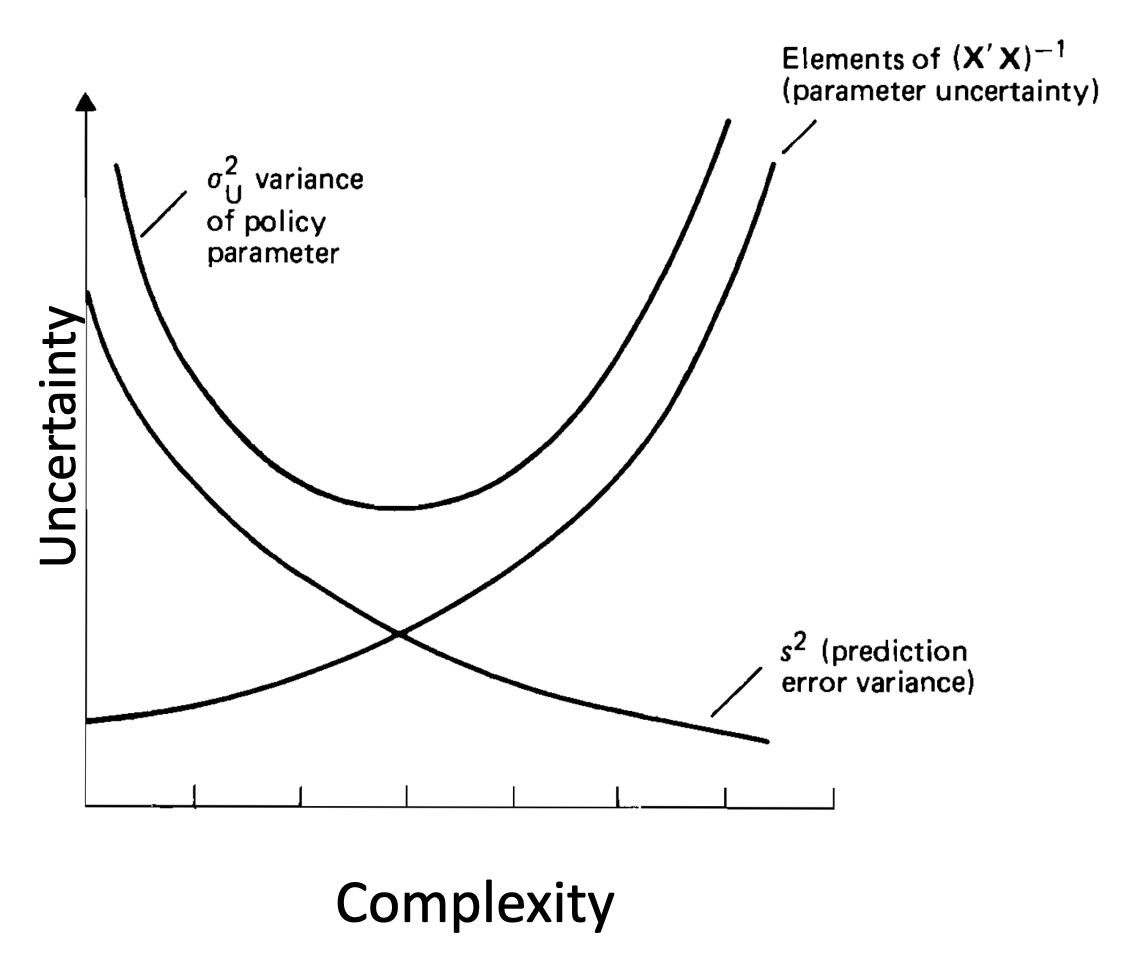3 Your research question?
So you want to build an ecosystem model. It should be very capable, it should be able to address any policy, management, environmental, population dynamic or ecological question about the resources in your ecosystem. If so, it has to be complex, it has to be end-to-end, include everything important from nutrients over whales to how society works. Right?
No, that thinking leads to Frankenstein models, models that take on a life of their own where no-one really knows why they behave the way they do. Instead the rule is: the simplest model that can address a given question is the best model to use. Best, because it’s the model with most predictive power[1].

Figure 1. Uncertainty about a policy parameters U (as expressed through its variance [latex]\sigma _U^2[/latex] is likely to be minimized at an intermediate complexity. Modified from Walters (1986[2]).
That rule also holds for working with EwE. Don’t spend years building a complex ecosystem model in order to address any question that may arise. Instead, close doors as you move ahead, build something simpler, as simple as you can get away with – you can always add details and see if it makes a difference. The model building process is a continuum you may never finish, recognize that and focus your effort. Make it a simple as you can in order to address the one thing that should be your guiding star: What is your research question?
Descriptive or predictive model? If descriptive you want to be inclusive, if predictive, be selective. See Defining the ecosystem.
Keeping it simple has several advantages, faster development and run times are just part of the picture. Equally as important is that keeping it as simple as possible makes it much more realistic to develop alternative models to address the research question that guides the work. It also makes it easier for you, the modeller to grasp what your model is doing and why.
Proponents of this principle have long advocated the use of Minimum Realistic Models[3] and Models of Intermediate Complexity for Ecosystem assessments[4], and this is indeed an approach that can go hand-in-hand with EwE model development and application.
Part of this is that models are not like religion, you can have more than one (and you shouldn’t believe them). So, if you find that a model can answer your question, should you believe the answer? No, evaluate how robust your findings are, don’t take them at face value. Examine your model and explore what it takes to make the answer go away. That doesn’t mean they are always wrong, but if you keep your model relatively simple, you can use alternative model formulation to explore the same or different questions. Consider and test if there are alternative hypotheses (and with it model formulations) that may be used to address the questions that drive your research.
Consider where we would be with climate change, if the IPCC had decided years ago to build one-model-that-rules-them-all to evaluate the mechanisms and impacts of climate change. We would still be arguing if what we are experiencing is climate change or natural variations. The approach that IPCC have taken by using an ensemble model approach represents the best way forward. IPBES has picked it up, and are using an ensemble approach to evaluate among other the impact of climate on fisheries and marine ecosystem through the Fish-MIP model intercomparison approach – of which EwE models are an integral part.
There may be an apparent conflict between keeping it as simple as possible and using an ensemble approach of perhaps more complex models, but that conflict is indeed only apparent.[5]
Holden et al.[6] provides a cost-benefit analysis of ecosystem modelling to support fisheries management. As part of this they evaluate not just benefit but model costs as well for models ranging from single-species models to complex ecosystem models. They found that costs varied by two orders of magnitude with cost increasing with model complexity. There are trade-offs and no “correct” way or “best” model. What matters is what is needed to answer the research/policy questions. That has to be defined from the very onset.
- Walters, C.J. 1986. Adaptive Management of Renewable Resources. MacMillan ↵
- Walters. 1986. op. cit. ↵
- D. S. Butterworth, É. E. Plagányi. 2004. A brief introduction to some approaches to multispecies/ecosystem modelling in the context of their possible application in the management of South African fisheries, African Journal of Marine Science, 26:1, 53-61 ↵
- Plagányi, É., Punt, A., Hillary, R., Morello, E., Thebaud, O., Hutton, T., Pillans, R., Thorson, J., Fulton, E.A., Smith, A.D.T., Smith, F., Bayliss, P., Haywood, M., Lyne, V., Rothlisberg, P. 2014. Multi-species fisheries management and conservation: tactical applications using models of intermediate complexity. Fish Fisheries 15:1-22. https://doi.org/10.1111/j.1467-2979.2012.00488.x ↵
- J. Elder. Chapter 16 - The apparent paradox of complexity in ensemble modeling R. Nisbet, G. Miner, K. Yale (Eds.), Handbook of Statistical Analysis and Data Mining Applications (Second edition), Academic Press, Boston (2018), pp. 705-718, https://doi.org/10.1016/B978-0-12-416632-5.00016-5 ↵
- Holden, M. H., Plagányi, E. E., Fulton, E. A., Campbell, A. B., Janes, R., Lovett, R. A., Wickens, M., Adams, M. P., Botelho, L. L., Dichmont, C. M., Erm, P., Helmstedt, K. J., Heneghan, R. F., Mendiolar, M., Richardson, A. J., Rogers, J. G. D., Saunders, K., & Timms, L. (2024). Cost–benefit analysis of ecosystem modeling to support fisheries management. Journal of Fish Biology, 1–8. https://doi.org/10.1111/jfb.15741 ↵

